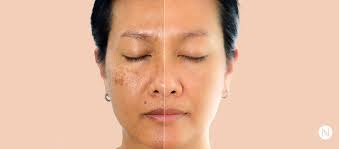Get Your AI Analysis
Personalized skincare insights
Discover your perfect skincare routine with our AI-powered analysis. Get personalized recommendations for glowing, healthy skin.
Start AnalysisFollow Us
Stay updated with the latest skincare tips, trends, and expert advice.
Sun-Induced Dark Spots: Prevention for All Skin Types
As a skincare professional with over a decade immersed in the ever-evolving world of dermatology and beauty, one topic consistently rises to the forefront of client concerns: dark spots. Specifically, those pesky brown patches that appear seemingly out of nowhere, often after a little too much time soaking up the sun. These are more than just cosmetic nuisances; they're a visual testament to sun damage, a powerful reminder of the sun's pervasive influence on our skin. While they can be a challenge to treat once they appear, the good news – and the focus of our deep dive today – is that they are largely preventable. Today, we're going to arm you with a comprehensive arsenal of strategies to keep sun-induced dark spots at bay, protecting your radiant complexion regardless of your skin type or tone.

Understanding the Enemy: How UV Exposure Triggers Melanin Production
Before we can effectively prevent, we must understand. Sun-induced dark spots, often referred to as solar lentigines, sun spots, or age spots, are the result of an overproduction of melanin – the pigment that gives our skin, hair, and eyes their color. Our skin contains specialized cells called melanocytes, which produce melanin. Their primary job? To protect our skin cells from harmful UV radiation.
When our skin is exposed to ultraviolet (UV) light, particularly UVA and UVB rays, it perceives this as a threat. In response, melanocytes go into overdrive, producing more melanin to create a protective barrier. This surge in melanin production, known as melanogenesis, can sometimes be unevenly distributed, leading to localized concentrations of pigment. These concentrations manifest as the dark spots we're all too familiar with. It's a defense mechanism gone slightly awry, leaving behind lasting evidence of sun exposure.
"Think of melanin as your skin's natural sunscreen. When UV rays hit, your skin deploys its defense. But chronic or intense exposure can overwhelm this system, leading to irregular melanin clumps that become visible dark spots. This process can affect all skin types, though post-inflammatory hyperpigmentation (PIH) is more common in darker skin tones." - Dr. Evelyn Reed, Board-Certified Dermatologist.
It's critical to note that UV radiation is present year-round, regardless of the weather. Even on cloudy days, up to 80% of UV rays can penetrate clouds. This underscores why prevention is not a seasonal task but a daily, year-round commitment.
The Non-Negotiable: Daily SPF 30+
If there's one message I could engrave on every skincare enthusiast's mind, it would be this: daily, consistent use of broad-spectrum sunscreen with an SPF of 30 or higher is the single most effective way to prevent sun-induced dark spots. This isn't just my opinion; it's backed by decades of dermatological research. A study published in the Journal of the American Academy of Dermatology demonstrated that regular sunscreen use significantly reduces the risk of developing solar lentigines.
Sunscreen Essentials:
- Broad-Spectrum Protection: Ensures protection against both UVA (aging rays) and UVB (burning rays). UVA rays are particularly implicated in hyperpigmentation.
- SPF 30+: Blocks approximately 97% of UVB rays. Higher SPFs offer slightly more protection but none block 100%.
- Daily Application: Apply it every single morning, rain or shine, even if you're staying indoors. UV rays can penetrate windows.
- Generous Amount: Most people apply too little. Use about a nickel-sized amount for your face and neck.
- Reapplication: Reapply every two hours, or immediately after swimming or excessive sweating.
For product recommendations, I always suggest finding a formula you *love* to ensure consistent use. Here are some top picks that offer excellent broad-spectrum protection for various skin types:
- For Oily/Acne-Prone Skin: EltaMD UV Clear Broad-Spectrum SPF 46 (mineral and chemical, lightweight, niacinamide helps with redness).
- For Dry/Sensitive Skin: La Roche-Posay Anthelios Melt-in Milk Sunscreen SPF 60 (chemical, hydrating, non-irritating).
- For All Skin Types (Mineral Option): Supergoop! Unseen Sunscreen SPF 40 (100% mineral, primer-like texture, clear finish).
- For Darker Skin Tones (No White Cast): Black Girl Sunscreen SPF 30 (chemical, dries completely clear, moisturizing).
Protective Measures Beyond Sunscreen
While sunscreen is paramount, it's not a license to bake in the sun. Think of it as the first line of defense in a multi-layered strategy. True sun protection involves holistic lifestyle adjustments.

1. Seek Shade & Avoid Peak Hours
The sun's rays are strongest between 10 AM and 4 PM. Plan your outdoor activities to avoid these peak hours whenever possible. If you must be outside, gravitate towards natural shade from trees or carry a parasol. Every minute spent in the shade reduces your overall UV exposure.
2. Embrace Protective Clothing & Accessories
Clothing acts as a physical barrier against UV radiation, offering superior protection compared to sunscreen alone in many cases. Look for:
- Wide-Brimmed Hats: A hat with a brim of at least 3 inches all around can shade your face, neck, and ears.
- UV-Protective Sunglasses: Choose sunglasses that block 99-100% of UVA and UVB rays to protect the delicate skin around your eyes.
- UPF Clothing: Clothing with an Ultraviolet Protection Factor (UPF) rating (similar to SPF for fabric) offers reliable protection. A UPF 30 garment blocks 97% of UV radiation. Brands like Coolibar and Mott50 offer stylish UPF apparel.
- Long Sleeves & Pants: Even regular tightly woven fabrics provide good protection. Darker colors and denim generally offer more protection than lighter colors and thin cotton.
3. Power Up with Antioxidants (Topical & Dietary)
Antioxidants are your skin's silent protectors, neutralizing free radicals generated by UV exposure. While they don't replace sunscreen, they offer an invaluable boost to your prevention strategy.
Topical Antioxidants:
Incorporate a serum rich in antioxidants into your morning routine, applied after cleansing and before sunscreen. They work synergistically with SPF to enhance protection against environmental damage.
- Vitamin C (L-Ascorbic Acid): A potent antioxidant that brightens skin, reduces hyperpigmentation, and boosts collagen. Look for formulations with 10-20%.
- Vitamin E (Tocopherol): Works well with Vitamin C, providing additional photoprotection and nourishing the skin.
- Ferulic Acid: Stabilizes Vitamins C and E, enhancing their efficacy.
- Niacinamide (Vitamin B3): Reduces inflammation, strengthens the skin barrier, and can help prevent the transfer of melanin to skin cells.
Product Recommendations:
- Skinceuticals CE Ferulic Serum: The gold standard, though pricey, for its potent Vitamin C, E, and Ferulic Acid combination.
- Mad Hippie Vitamin C Serum: A more budget-friendly option with Vitamin C, Vitamin E, Ferulic Acid, and Hyaluronic Acid.
- The Ordinary Niacinamide 10% + Zinc 1%: Excellent for barrier support and melanin management.
Dietary Antioxidants:
What you eat can also support your skin's defenses. A diet rich in fruits, vegetables, and whole grains provides internal antioxidant protection.
- Berries & Leafy Greens: Packed with Vitamin C and other phytonutrients.
- Tomatoes & Watermelon: Rich in lycopene, which has photoprotective properties.
- Green Tea: Contains polyphenols that act as powerful antioxidants.

A Holistic Approach for All Skin Types and Tones
It's a common misconception that individuals with darker skin tones don't need to worry about sun protection. This couldn't be further from the truth. While darker skin has more melanin and a slightly higher natural SPF, it is still susceptible to sun damage, including dark spots. In fact, darker skin tones are often more prone to Post-Inflammatory Hyperpigmentation (PIH), which can be exacerbated by sun exposure, making prevention even more crucial.
"Every skin tone, from Fitzpatrick I to VI, requires rigorous sun protection. For individuals with richer skin tones, sun exposure can trigger not just solar lentigines, but also worsen conditions like melasma and post-inflammatory hyperpigmentation, which can be particularly stubborn to treat. Prevention is truly universal." - Dr. Marcus Thorne, Cosmetic Dermatologist.
Consistency is key in prevention. It's not about being perfect one day, but consistently applying these strategies every day. Make sun protection a non-negotiable step in your daily routine, just like brushing your teeth. Educate yourself on the UV index in your area and adjust your protection accordingly. Remember that surfaces like snow, sand, and water can reflect UV rays, intensifying exposure. Even indoor lighting, particularly fluorescent and LED lights, can emit small amounts of UV and visible light that contribute to skin aging and hyperpigmentation over time, another reason why that daily SPF is so important.
Quick Prevention Checklist:
- Apply broad-spectrum SPF 30+ daily, year-round.
- Reapply sunscreen every 2 hours during prolonged outdoor activity.
- Wear wide-brimmed hats and UV-protective sunglasses.
- Opt for UPF clothing for extended sun exposure.
- Seek shade, especially between 10 AM and 4 PM.
- Incorporate topical antioxidant serums (e.g., Vitamin C, Niacinamide) into your morning routine.
- Maintain a diet rich in dietary antioxidants.
- Be mindful of reflective surfaces like water and snow.
Preventing sun-induced dark spots is a long-term investment in your skin's health and appearance. It's about protecting your skin from the inside out, leveraging both topical products and smart lifestyle choices. Don't underestimate the cumulative effect of daily sun exposure. Each ray adds up, and consistent prevention is your best defense against visible signs of sun damage. By integrating these strategies into your daily life, you're not just preventing dark spots; you're safeguarding your skin's overall vitality and youthful glow for years to come. Remember, prevention is always easier, and far more cost-effective, than treatment.

